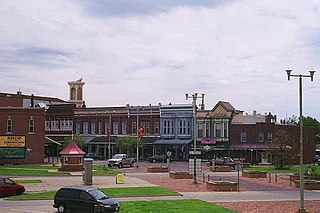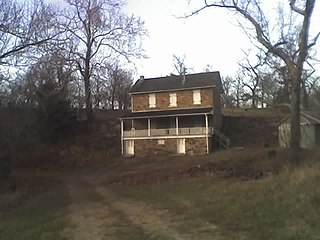
Fort Scott is a city in and the county seat of Bourbon County, Kansas, United States, 88 miles (142 km) south of Kansas City, on the Marmaton River. As of the 2010 census, the city population was 8,087. It is the home of the Fort Scott National Historic Site and the Fort Scott National Cemetery. Fort Scott is named for Gen. Winfield Scott.

Butler is a city in Bates County, Missouri, United States. The population was 4,219 at the 2010 census. The county seat of Bates County, the city is named for William Orlando Butler, a noted American military and political figure of the early and mid-19th century. It is located approximately fifty miles south of Kansas City, Missouri on U.S. Route 71-Interstate 49.
The history of Kansas, argued historian Carl L. Becker a century ago, reflects American ideals. He wrote:
Jayhawkers and red legs are terms that came to prominence in Kansas Territory, during the Bleeding Kansas period of the 1850s; they were adopted by militant bands affiliated with the free-state cause during the American Civil War. These gangs were guerrillas who often clashed with pro-slavery groups from Missouri, known at the time in Kansas Territory as "Border Ruffians". After the Civil War, the word "Jayhawker" became synonymous with the people of Kansas, or anybody born in Kansas. Today a modified version of the term, Jayhawk, is used as a nickname for a native-born Kansan, but more typically for a student, fan, or alumnus of the University of Kansas.

William Porcher Miles was among the ardent states' rights advocates, supporters of slavery, and Southern secessionists who came to be known as the "Fire-Eaters." He is notable for having designed the most popular variant of the Confederate flag, originally rejected as the national flag in 1861 but adopted as a battle flag by the Army of Northern Virginia under General Robert E. Lee before it was reincorporated.

Price's Missouri Expedition, also known as Price's Raid, was a Confederate raid through the states of Missouri and Kansas in the Trans-Mississippi Theater of the American Civil War during the autumn of 1864. Led by Confederate Major General Sterling Price, the campaign's intention was to recapture Missouri and renew the Confederate initiative in the larger conflict.

To a large extent, the American Civil War was fought in cities and farms of Tennessee, as only Virginia saw more battles. However, Tennessee is the only state to have major battles or skirmishes fought in every single county. Tennessee was the last of the Southern states to declare secession from the Union as a substantial portion of the population were against secession, but saw more than its share of the devastation resulting from years of warring armies criss-crossing the state. Its rivers were key arteries to the Deep South, and, from the early days of the war, Union efforts focused on securing control of those transportation routes, as well as major roads and mountain passes such as the Cumberland Gap. Tennessee was also considered "the Bread Basket" of the Confederacy, for its rich farmland that fed both armies during the war.

The Skirmish at Island Mound was a skirmish of the American Civil War, occurring on October 29, 1862, in Bates County, Missouri. The Union victory is notable as the first known event in which an African-American regiment engaged in combat against Confederate forces during the war.

Charles Rainsford Jennison also known as "Doc" Jennison was a member of the anti-slavery faction during Bleeding Kansas, a famous Jayhawker, and a member of the Kansas State Senate in the 1870s. He later served as a Union colonel and as a leader of Jayhawker militias during the American Civil War. He was famously quoted as refusing to allow any pro-slavery soldiers to serve with him, and said, "the slaves of [southerners] can always find a protection in... [my] camp, and they will be defended to the last man and bullet."
Kansas has always been home to many forts and military posts.
Fort Lincoln was established about August 24, 1861, by United States Senator James Lane. Earlier in August, Lane had reestablished Fort Scott as a military post. Soon Confederate troops under Maj. Gen. Sterling Price threatened to overrun the newly reopened post.
Fort Lookout, in the northeast corner of Republic County, Kansas, was established by the US Army near the beginning of the American Civil War, in 1861. Its purpose was to protect the military road running from Fort Riley, Kansas, to Fort Kearney, Nebraska Territory. The area witnessed many attacks by Indians. Fort Lookout was perched on a high bluff overlooking the Republican River. The fort was two miles south of the Kansas-Nebraska border.
Potosi's post, in eastern Linn County, Kansas, was established at the small town of Potosi, Kansas, founded in 1857 by those loyal to the southern cause in Kansas. The other side, the free-staters, soon gained control of the town and it was loyal to the Union when the Civil War broke out in 1861. Potosi was located along the north bank of Mine Creek and it was along the military road running from Fort Leavenworth to Fort Gibson. At its height the town had thirty residents, a store and a post office.
Franklin was a small town established in 1854 in Douglas County, Kansas Territory. Established as a proslavery stronghold, the town played a key role in the "Bleeding Kansas" conflict that troubled the territory in the 1850s.
Fort Saunders, 4 miles (6.4 km) southeast of Clinton, Kansas, and 12 miles (19 km) southwest of Lawrence, Kansas, was owned by James D. Saunders, a militia captain. What little was left of Clinton disappeared during construction of the Clinton Lake in the 1960s; only an outbuilding that was converted into a museum remains.











